Jim Stephenson: architecture as stageset for a film
In a new exhibition at the RIBA in London, architectural photographer & filmmaker Jim Stephenson uses fragments of footage from assorted recent buildings to create a meditative film focusing on how people inhabit architecture.
There is a strange moment in a building’s life when it exists
through a short-lived adolescence. After first being a glint in an architects’
eye, who then nurtures it through the first few years of becoming itself before,
if everything goes well, it will enter the puberty of the construction site.
But it is not yet adult, not yet settled into its being and fully ready to
tackle the journey to old age.
There is an adolescence when it is neither pubescent nor grown up, when it is no longer under the care of the architect, yet no longer a space occupied by those it was designed to work for – whether they be residents, students, workers, or those at leisure. Architectural media is obsessed by this adolescent period of a building, when it has grown into a full form and looks like architecture, but it bears none of the scuff marks of having lived and has not been tested in real world situations. This is when architectural press tour a new building, when it first appears on the radars of annual awards judges, and when architectural photographers visit to make record of it as a place still immaculate and fresh-faced.
![]()
![]()
![]()
“The history of architectural images is a history of omitting people,” Jim Stephenson says at the opening of a new exhibition in the gallery of the Royal Institute of British Architects in London. There is a formalism and language of architectural photography which celebrates the building, its geometries, shadows, and materials, and it rarely includes any human figure, let alone the very human figures the place was designed and built for and who will go on to live with the building. However, even when photographing a new building, it is impossible to separate the place from its occupation: “I work with the camera, but the work I do with the camera is limited – most of my time is spent observing the light and watching people,” Stephenson explains, his new work documenting building, light, and people.
For various architects and publications, Stephenson gets sent around the country to photograph and film newly finished building projects, in many cases some of the most celebrated projects which go on to win national awards. For short documenting films, often presented without sound in their final form, Stephenson rarely needs footage longer than ten or fifteen seconds, which he carefully then cuts to create a choreography of place in a final short film used within journalistic coverage or on an architect’s website. He records much more, however, and his diptych The Architect Has Left The Building uses these fragments in a more artistic way to record how architecture is used by its very first occupants, over a building’s first few days of adulthood.
“Most publications don’t want five minutes of footage of people on a bench,” Stephenson explains. Here, however, he has freedom to begin the film with a long, still shot of a bench built into the façade of Hackney New School, designed by Henley Halebrown. We observe both building and people just being, not having to perform for the camera, and with a photographer expecting nothing other than dispassionate observation. We see parents and children congregating, sitting, and standing on the bench.
For the 2014 Venice Architecture Biennale, curators Yvonne Farrell and Shelley McNamara of Grafton Architects wanted to explore the idea of generosity in architecture, giving the example of the bench built into the wall of Florence’s Medici Palace as a case in point of how even fortress-like architecture can give something back: “What is solid seems outward looking and generous.” Here, Stephenson captures a similarly simple architectural gesture, occupied as a moment of respite for a resting pedestrian, kids playing, and parents waiting.
![]()
The whole film is thirty minutes long, though designed as a loop so viewers can drop in and out at any point. In a generally sequential order, it drifts between various buildings, including Cambridge Central Mosque by Marks Barfield Architects, Windemere Jetty Museum by Carmody Groarke, and the Town House at Kingston University by Grafton Architects. But it is less interested in capturing any building in its totality, so much as more oblique observations of how people use it. Beyond the presence of people, there are other clues as to these places having started their adult life: the swimming pool has a single blue ball floating across the water, there are chalk drawings on a school playground, salty stains mark the window overlooking Lake Windemere.
In footage of Nicholas Grimshaw’s new London Bridge Station, it’s interesting to observe that despite Stephenson recording the space so shortly after its new reconfiguration had publicly opened, commuters are using it as if it had always been as it now is. The speed at which architecture is adopted and becomes a solid component of physical and social place, despite having had such a long period of gestation and development without any human presence, is testament to how good design doesn’t so much need to shout its presence and idea, so much as provide a considered and solid base from which human activity can thrive – or as Stephenson states, “architecture as backdrop, as stageset.”
![]()
In the task of choosing and editing the footage, Stephenson was joined by artist Sofia Kathryn Smith, who helped to add playfulness and moments of uncanny to the pairing and shifting of images. The outlet of a waterslide at Britannia Leisure Centre, designed by Faulkner Brown Architects is juxtaposed next to waves crashing against the Cornish cliffs under William Matthews Architects’ Tintagel Bridge. Two children sit on the floor of Sands End Arts & Community Centre by Mae, as in the adjoining screen two adults similarly rest and recover on the floor of a squash court.
Over the top there is a soundtrack which seeks to add a further layer of uncanny. Stephenson gave sound artist Simon James freedom to take the sound where he wanted, and he clearly had fun. Much of Stephenson’s footage was recorded without consideration to sound due to its final function being silent presentation, and so when in locations he was not recording with microphones of enough quality for this unplanned for artwork. In some instances, James used contact mics on the buildings themselves so, as Stephenson puts it, “you can hear its inner growlings,” while elsewhere and in true foley-style, James recorded sound effects such as walking up steps to overlay onto the film, and in other instances folded in sounds totally disconnected from the source footage. Collaborating with James and Smith adds enough creative layers help shift the final film away from promotional documentation and just into the territory of fine-art.
Outside of the projection room, there are two secondary displays which add context. Vitrines display fragments of assorted ephemera connected to many of the projects, including the blue ball we saw floating in the film alongside architectural drawings, a school term timetable, and material samples. A small corridor space presents single images from each project, a reminder of Stephenson’s initial commercial job at each location, before he repurposed leftover footage into this film in order to present an altogether different rendering of place.
![]()
![]()
![]()
There is an adolescence when it is neither pubescent nor grown up, when it is no longer under the care of the architect, yet no longer a space occupied by those it was designed to work for – whether they be residents, students, workers, or those at leisure. Architectural media is obsessed by this adolescent period of a building, when it has grown into a full form and looks like architecture, but it bears none of the scuff marks of having lived and has not been tested in real world situations. This is when architectural press tour a new building, when it first appears on the radars of annual awards judges, and when architectural photographers visit to make record of it as a place still immaculate and fresh-faced.
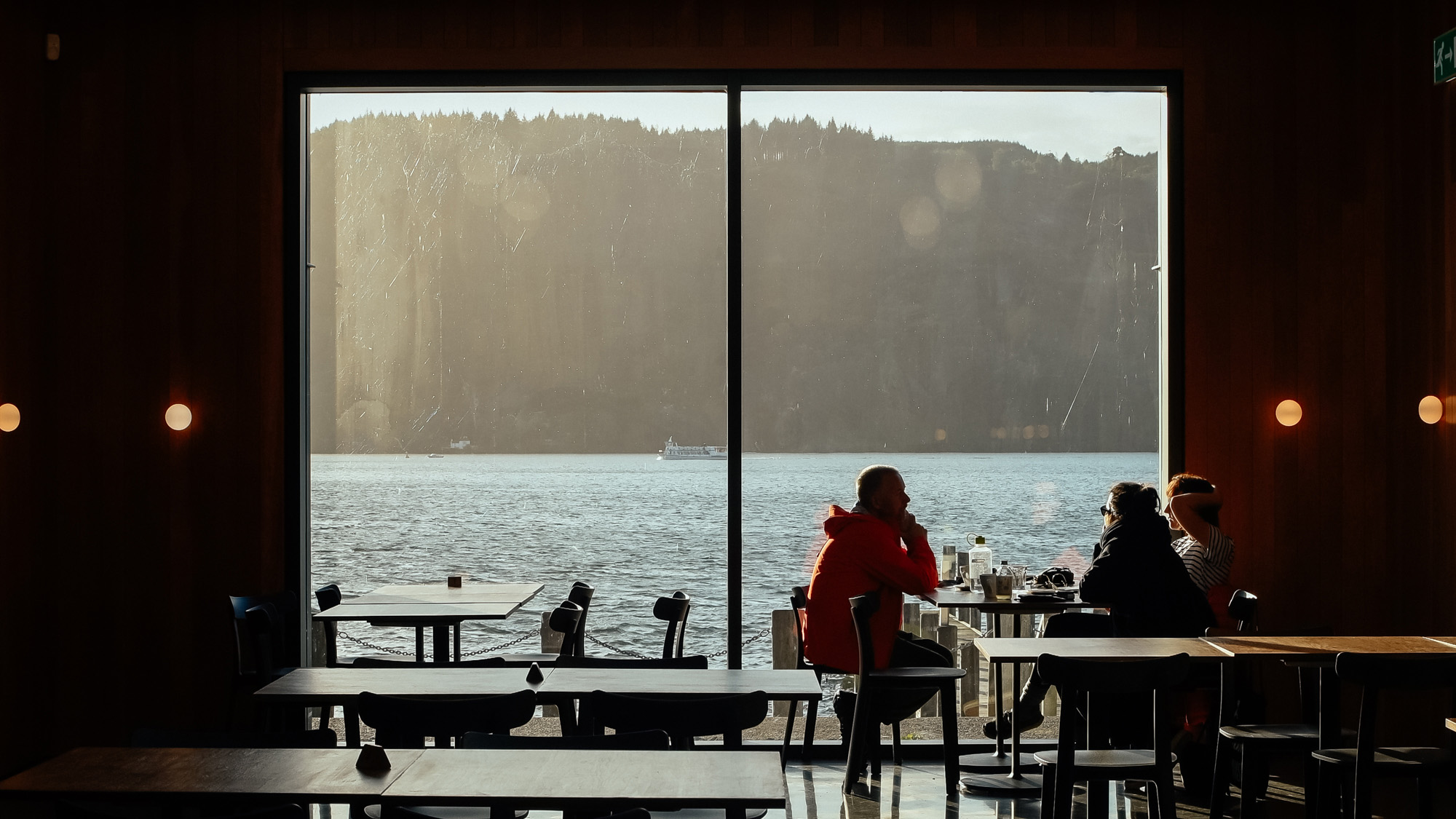
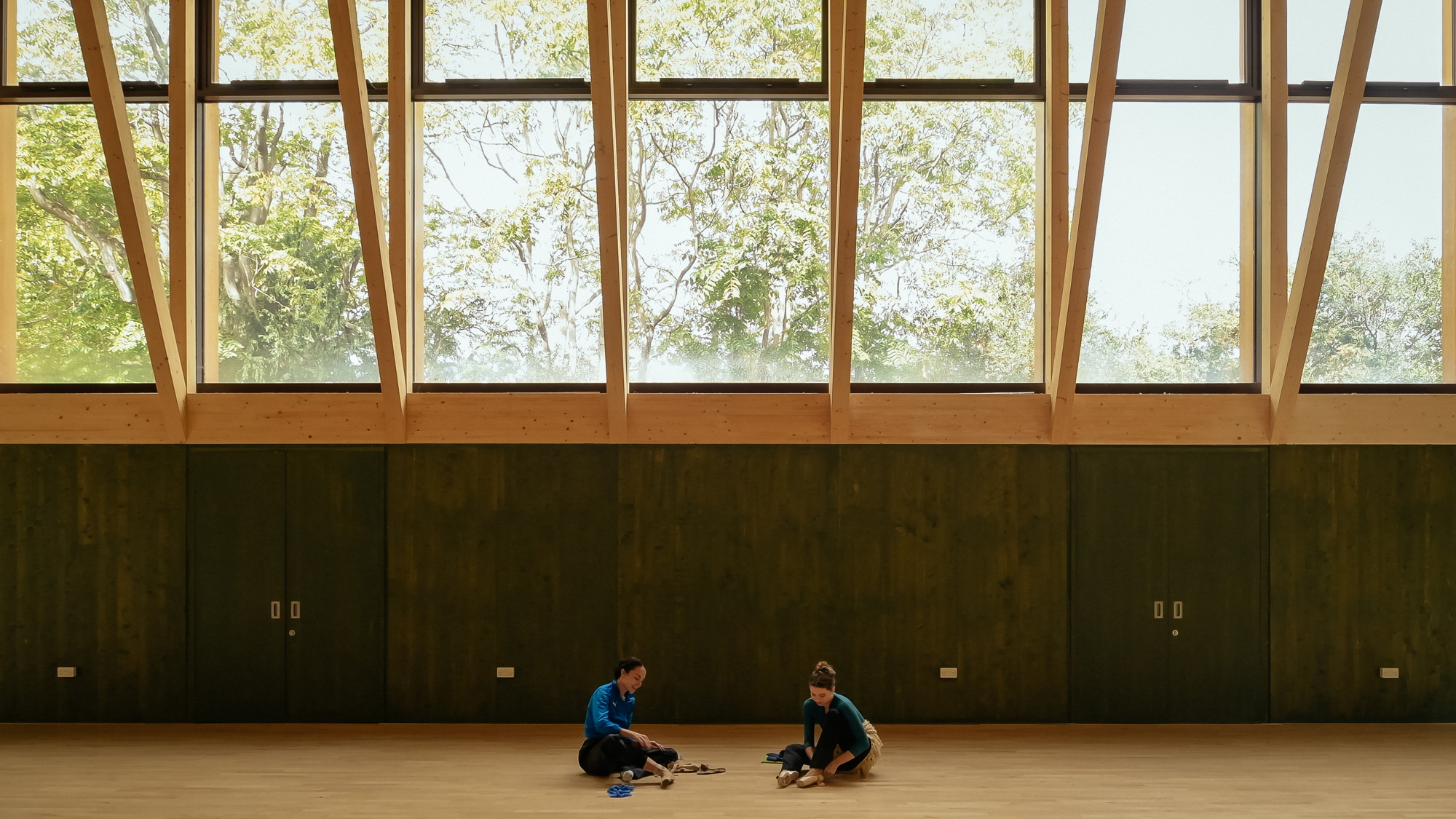
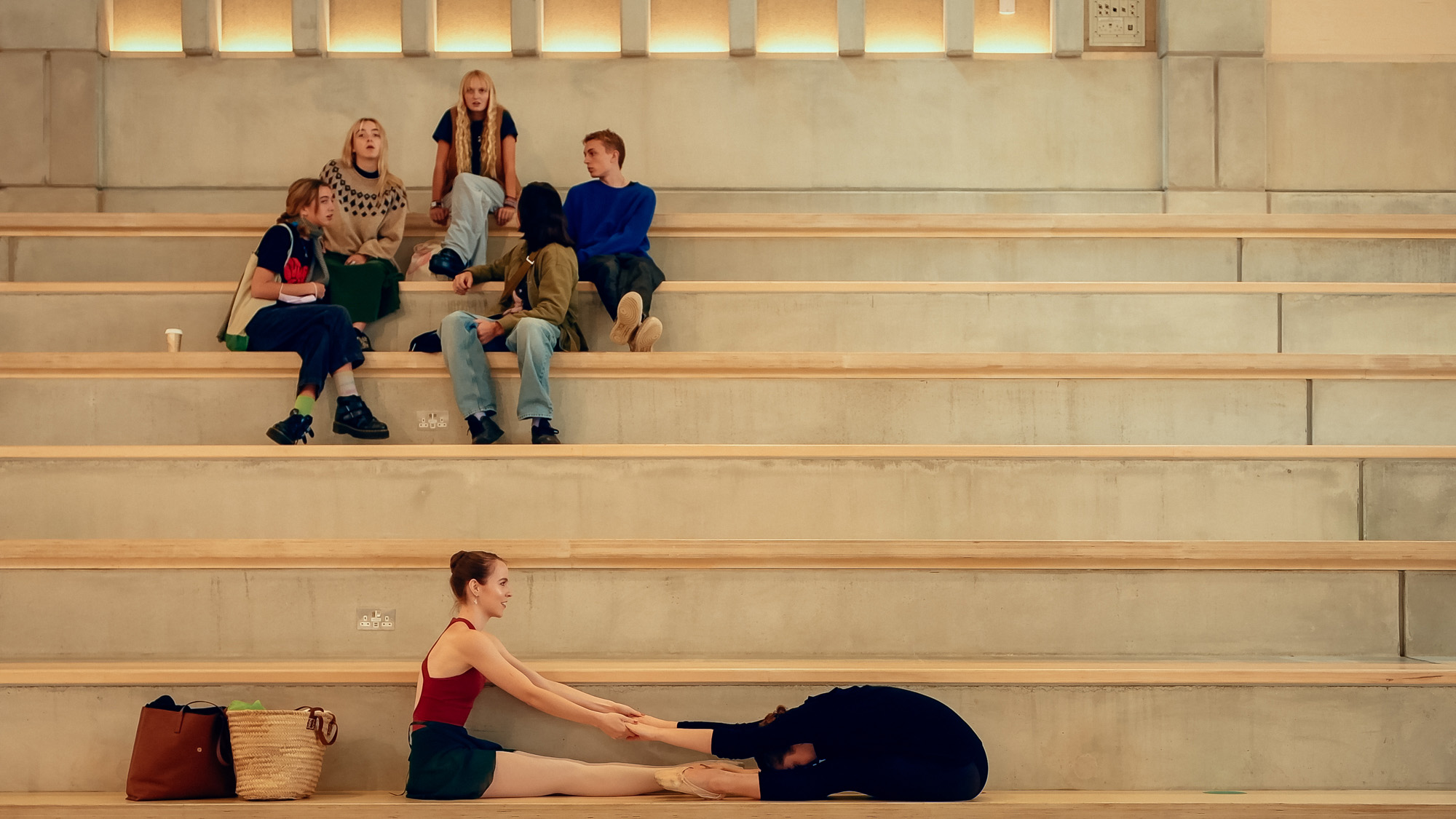
Figs.i-iii
“The history of architectural images is a history of omitting people,” Jim Stephenson says at the opening of a new exhibition in the gallery of the Royal Institute of British Architects in London. There is a formalism and language of architectural photography which celebrates the building, its geometries, shadows, and materials, and it rarely includes any human figure, let alone the very human figures the place was designed and built for and who will go on to live with the building. However, even when photographing a new building, it is impossible to separate the place from its occupation: “I work with the camera, but the work I do with the camera is limited – most of my time is spent observing the light and watching people,” Stephenson explains, his new work documenting building, light, and people.
For various architects and publications, Stephenson gets sent around the country to photograph and film newly finished building projects, in many cases some of the most celebrated projects which go on to win national awards. For short documenting films, often presented without sound in their final form, Stephenson rarely needs footage longer than ten or fifteen seconds, which he carefully then cuts to create a choreography of place in a final short film used within journalistic coverage or on an architect’s website. He records much more, however, and his diptych The Architect Has Left The Building uses these fragments in a more artistic way to record how architecture is used by its very first occupants, over a building’s first few days of adulthood.
“Most publications don’t want five minutes of footage of people on a bench,” Stephenson explains. Here, however, he has freedom to begin the film with a long, still shot of a bench built into the façade of Hackney New School, designed by Henley Halebrown. We observe both building and people just being, not having to perform for the camera, and with a photographer expecting nothing other than dispassionate observation. We see parents and children congregating, sitting, and standing on the bench.
For the 2014 Venice Architecture Biennale, curators Yvonne Farrell and Shelley McNamara of Grafton Architects wanted to explore the idea of generosity in architecture, giving the example of the bench built into the wall of Florence’s Medici Palace as a case in point of how even fortress-like architecture can give something back: “What is solid seems outward looking and generous.” Here, Stephenson captures a similarly simple architectural gesture, occupied as a moment of respite for a resting pedestrian, kids playing, and parents waiting.
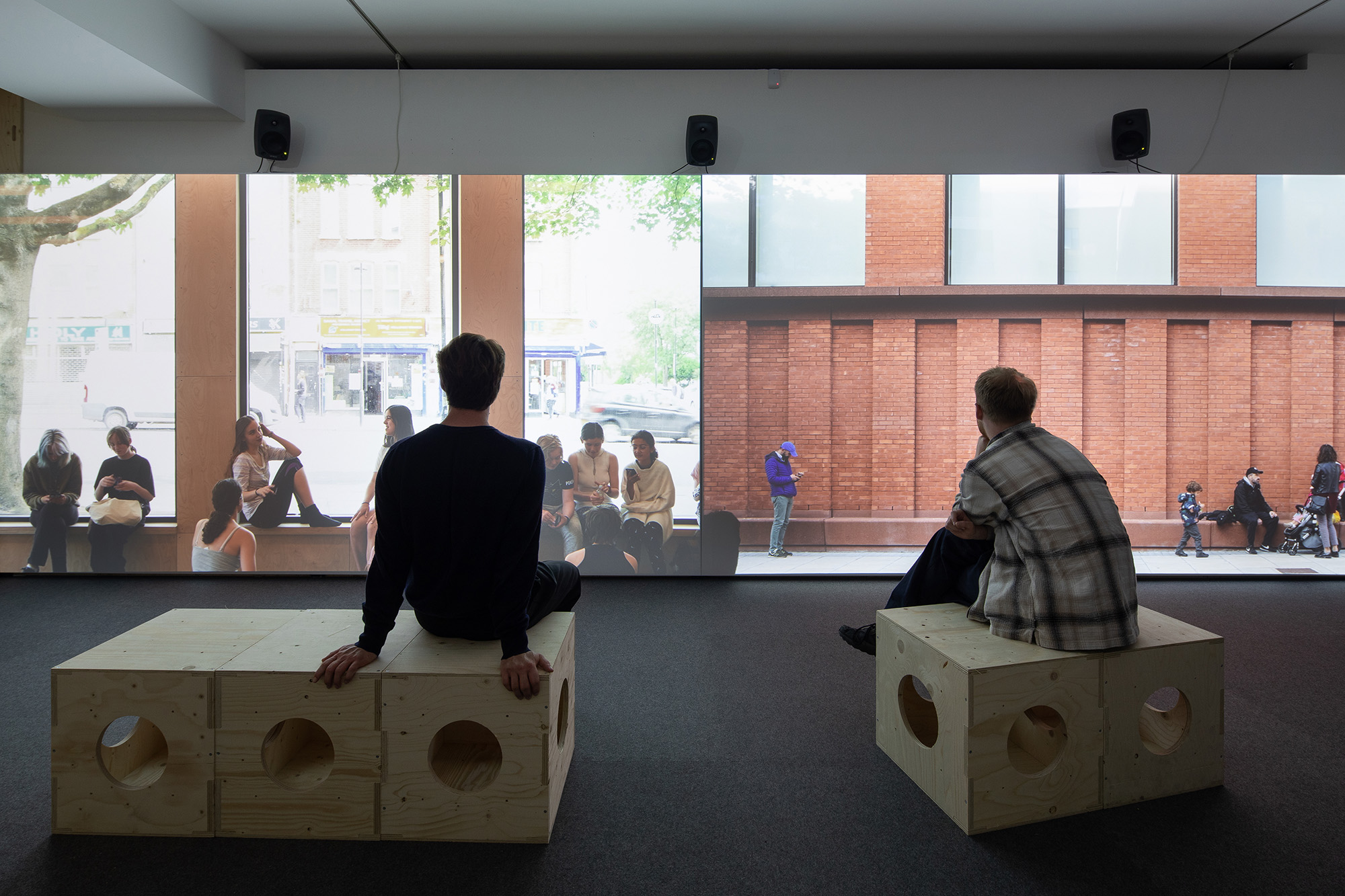
Fig.iv
The whole film is thirty minutes long, though designed as a loop so viewers can drop in and out at any point. In a generally sequential order, it drifts between various buildings, including Cambridge Central Mosque by Marks Barfield Architects, Windemere Jetty Museum by Carmody Groarke, and the Town House at Kingston University by Grafton Architects. But it is less interested in capturing any building in its totality, so much as more oblique observations of how people use it. Beyond the presence of people, there are other clues as to these places having started their adult life: the swimming pool has a single blue ball floating across the water, there are chalk drawings on a school playground, salty stains mark the window overlooking Lake Windemere.
In footage of Nicholas Grimshaw’s new London Bridge Station, it’s interesting to observe that despite Stephenson recording the space so shortly after its new reconfiguration had publicly opened, commuters are using it as if it had always been as it now is. The speed at which architecture is adopted and becomes a solid component of physical and social place, despite having had such a long period of gestation and development without any human presence, is testament to how good design doesn’t so much need to shout its presence and idea, so much as provide a considered and solid base from which human activity can thrive – or as Stephenson states, “architecture as backdrop, as stageset.”
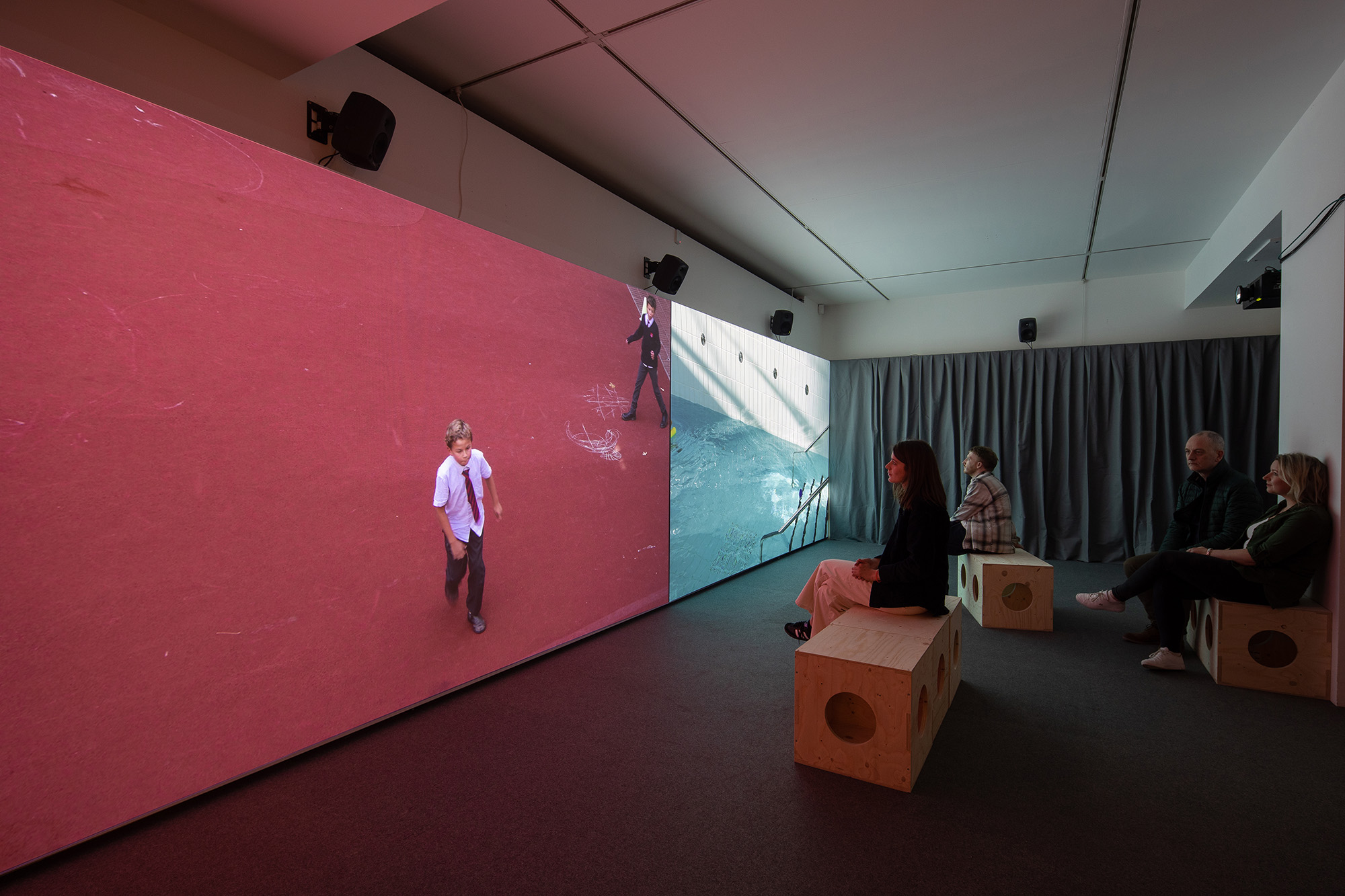
Fig.v
In the task of choosing and editing the footage, Stephenson was joined by artist Sofia Kathryn Smith, who helped to add playfulness and moments of uncanny to the pairing and shifting of images. The outlet of a waterslide at Britannia Leisure Centre, designed by Faulkner Brown Architects is juxtaposed next to waves crashing against the Cornish cliffs under William Matthews Architects’ Tintagel Bridge. Two children sit on the floor of Sands End Arts & Community Centre by Mae, as in the adjoining screen two adults similarly rest and recover on the floor of a squash court.
Over the top there is a soundtrack which seeks to add a further layer of uncanny. Stephenson gave sound artist Simon James freedom to take the sound where he wanted, and he clearly had fun. Much of Stephenson’s footage was recorded without consideration to sound due to its final function being silent presentation, and so when in locations he was not recording with microphones of enough quality for this unplanned for artwork. In some instances, James used contact mics on the buildings themselves so, as Stephenson puts it, “you can hear its inner growlings,” while elsewhere and in true foley-style, James recorded sound effects such as walking up steps to overlay onto the film, and in other instances folded in sounds totally disconnected from the source footage. Collaborating with James and Smith adds enough creative layers help shift the final film away from promotional documentation and just into the territory of fine-art.
Outside of the projection room, there are two secondary displays which add context. Vitrines display fragments of assorted ephemera connected to many of the projects, including the blue ball we saw floating in the film alongside architectural drawings, a school term timetable, and material samples. A small corridor space presents single images from each project, a reminder of Stephenson’s initial commercial job at each location, before he repurposed leftover footage into this film in order to present an altogether different rendering of place.

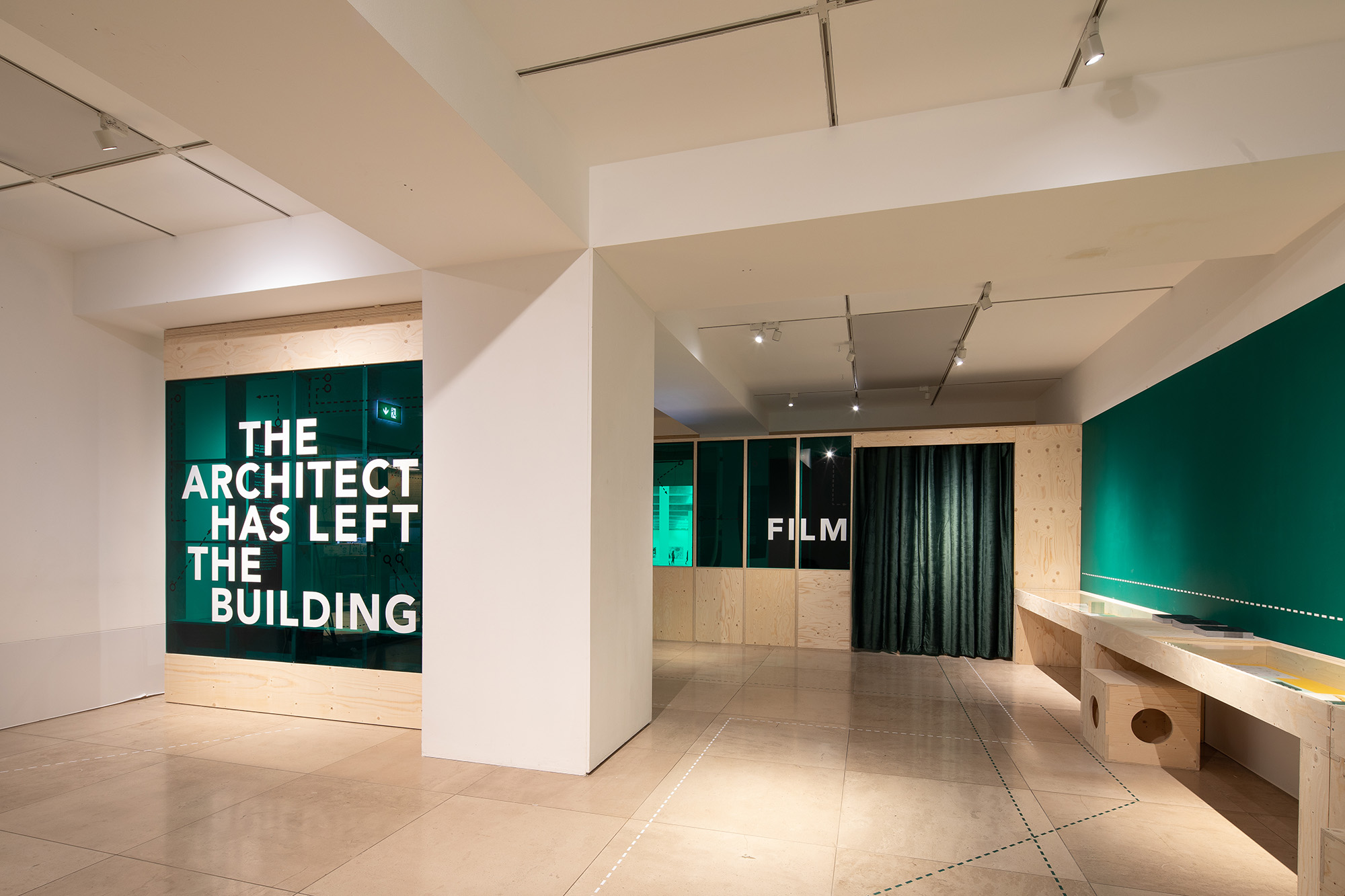
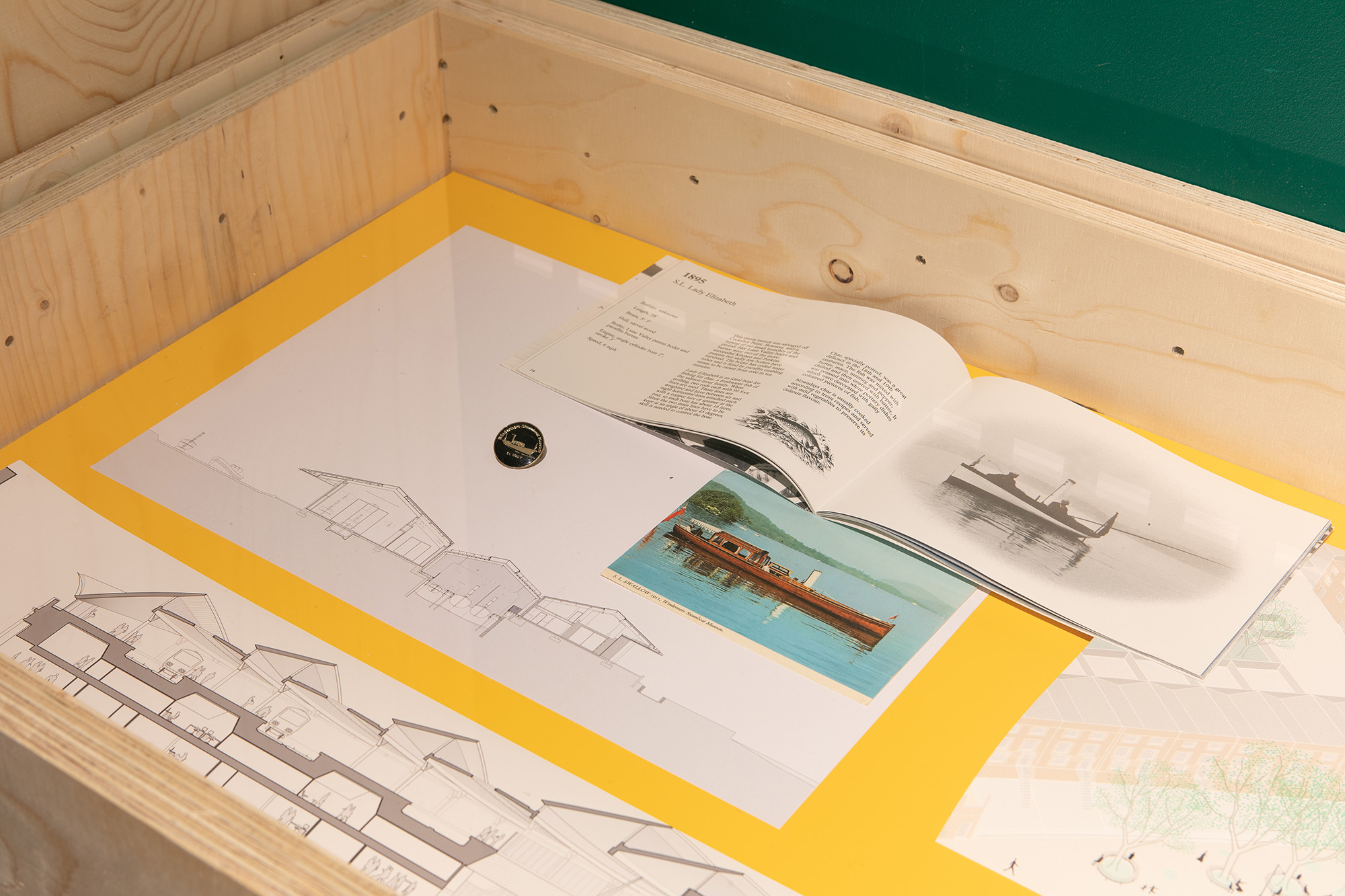
Figs.vi-viii
Jim Stephenson has a degree in Architectural Technology, and
after working in practice for several years both in the UK and US, he turned to
photography (over 15 years ago) and has been working internationally ever
since. He is also the founder of the
non-profit arts organisation Miniclick which has striven to eliminate the
culture of gatekeeping in the photography world for over 10 years. His
photography and filmmaking work is hallmarked by a passion for community led
projects, and a keen eye for human interaction with architecture and design,
often reflecting the multi-sensory experience of spending time in the build
environment. Jim’s award-winning photography and films have a mediative
documentary style, and he has cultivated a specialist practice which allows for
fleeting moments of light, and people at play to be celebrated.
www.clickclickjim.com
Sofia Smith is a writer, researcher and visual artist with an
educational background in English Literature, Critical Theory, Creative Writing
and Fine Art Photography. She has worked in collaboration with artists,
designers and photographers for many years, often in research, art direction
and curatorial roles, as well as editing and planning. She is the co-founder of
Capturing The Chimera; an arts education organisation that teaches
interdisciplinary approaches to creativity and a curatorial member of the
non-profit photography group Miniclick. Her personal work shows her interest in
collaborative creative practice, acts of transformation, collection and
compulsion, as well as an interest in mythology and folklore. Sofia is the
studio manager at Stephenson& and
brings her knowledge of storytelling to the pre-production and editing
process.
www.stephensonand.com
Simon James is a self-trained sound artist whose work is
exploratory and instinctive, focussed on timbral shaping, finding the sounds in
between the sounds and the relationship between these and field recordings.
www.simonsound.co.uk
www.stephensonand.com
Simon James is a self-trained sound artist whose work is
exploratory and instinctive, focussed on timbral shaping, finding the sounds in
between the sounds and the relationship between these and field recordings.
www.simonsound.co.uk
visit
The Architect Has Left The Building, by Jim Stephenson, is exhibited at the Royal Institute of British Architects, London. Free entry, more information available at:
www.architecture.com/explore-architecture/exhibitions/The-Architect-has-Left-the-Building
images
fig.i
Windemere Jetty Museum Carmoady Groake. © Jim Stephenson
fig.ii Sands End Mae Architects. © Jim Stephenson
fig.iii Kingston Town House Grafton Architects. © Jim Stephenson
figs.iv-viii Installation images of The Architect Has Left The Building. © Agnese Sanvito
publication date
01 June 2022
tags
Architectural photography, Architectural film, Carmody Groarke, DSDHA, Faulkner Brown Architects, Feilden Fowles, Film, Grafton Architects, Grimshaw, Henley Halebrown, Images, Simon James, Jamie Fobert Architects, Mae, Marks Barfield, Niall McLaughlin Architects, People, Photography, Thomas Randall Page, RIBA, Benedetta Rogers, Sitting, Sofia Smith, Jim Stephenson, Jonathan Tuckey, Venice Architecture Biennale, William Matthews Architects
www.architecture.com/explore-architecture/exhibitions/The-Architect-has-Left-the-Building


